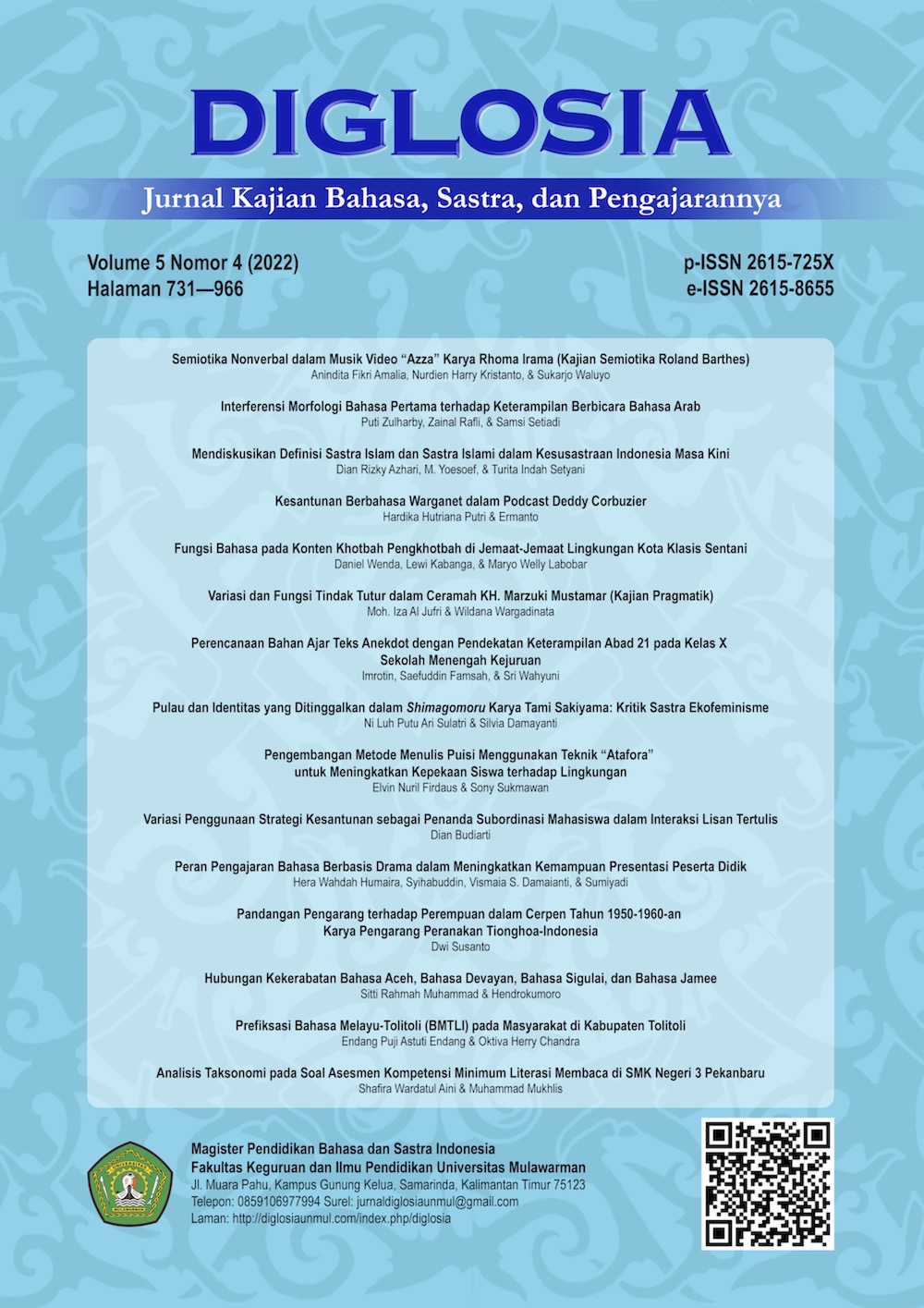Pulau dan Identitas yang Ditinggalkan dalam Shimagomoru Karya Tami Sakiyama: Kritik Sastra Ekofeminisme
Main Article Content
Abstract
Tami Sakiyama in Shimagomoru criticises homogeneity, dominance, and centralisation influencing the thinking model and development strategy in Okinawa, causing violence toward society and the environment. This article examines the construction of discourse in Shimagomoru related to colonisation in Okinawa and its impact on the environment and universal bioethics through an ecofeminist literary criticism approach. The data in the study were collected through the literature review method and analysed through the descriptive analysis method. Results of this study showed that the islands abandoned by their inhabitants due to moving to the more advanced and modern main islands are the result of discrimination in modernisation and development in Okinawa. Colonisation, annexation, and assimilation created a single identity as Japanese for Okinawans, causing identity ambiguity.
Downloads
Article Details
![]()
Every work in Diglosia: Jurnal Kajian Bahasa, Sastra, dan Pengajarannya is licensed under a Creative Commons Attribution-ShareAlike 4.0 International License.
Under the following terms:
- Attribution — You must give appropriate credit , provide a link to the license, and indicate if changes were made . You may do so in any reasonable manner, but not in any way that suggests the licensor endorses you or your use.
- ShareAlike — If you remix, transform, or build upon the material, you must distribute your contributions under the same license as the original.
- No additional restrictions — You may not apply legal terms or technological measures that legally restrict others from doing anything the license permits.
Authors who publish with this journal agree to the following terms:
- Authors retain copyright and grant the journal right of first publication with the work simultaneously licensed under a CC BY-SA 4.0 DEED Attribution-ShareAlike 4.0 Internationalthat allows others to share the work with an acknowledgment of the work's authorship and initial publication in this journal.
- Authors are able to enter into separate, additional contractual arrangements for the non-exclusive distribution of the journal's published version of the work (e.g., post it to an institutional repository or publish it in a book), with an acknowledgment of its initial publication in this journal.
- Authors are permitted and encouraged to post their work online (e.g., in institutional repositories or on their website) prior to and during the submission process, as it can lead to productive exchanges, as well as earlier and greater citation of published work.
References
Bhowmik, D. L. (2008). Writing Okinawa: Narrative Acts of Identity and Resistance. Routledge.
Fatkhurridho, F., & Rusdiarti, S. R. (2022). Ekofeminsime dalam Film Nona Kedi yang Tak Pernah Melihat Keajaiban (2013). Diglosia: Jurnal Kajian Bahasa, Sastra, Dan Pengajarannya, 5(3), 695–706. https://doi.org/10.30872/diglosia.v5i3.471
Gaard, G., & Murphy, P. D. (1996). A Dialogue on the Role and Place of Literary Criticism Within Ecofeminism. Interdisciplinary Studies in Literature and Environment, 3(1), 1–6. https://doi.org/10.1093/isle/3.1.1
Geçgil, E. (2016). Mary Austin’s Proto-ecofeminist Land Ethic in the Ford (1917) and the Owens Valley Water Controversy. In D. A. Vakoch & S. Mickey (Eds.), Literature and Ecofeminism Intersectional and International Voices (pp. 40–53). Routledge.
Hein, I. (2010). Constructing Difference in Japan: Literary Counter-images of the Okinawa Boom. Contemporary Japan, 22(1–2). https://doi.org/10.1515/cj.2010.011
Hein, L. E., & Selden, M. (2003). Culture, Power, and Identity in Contemporary Japan. In L. E. Hein & M. Selden (Eds.), Islands of Discontent: Okinawan Responses to Japanese and American Power (Asian Voices) (pp. 1–35). Rowman & Littlefield Publishers.
Iwabuchi, K., Osamu, T., & Yasuhiro, T. (2004). Okinawa ni Tachisukumu Daigaku o Koete Shinka Suru Chi. Serika Shobo.
Kina, I. (2022). Indigenous Women’s Storytelling in Resistance and Resilience: The Stories of Liglav A-Wu and Tami Sakiyama. Okinawan Journal of Island Studies, 3, 47–54.
Ko, M. (2006). Takamine Go: A Possible Okinawan Cinema. Inter-Asia Cultural Studies, 7(1), 156–170. https://doi.org/10.1080/14649370500463844
Legler, G. T. (1997). Ecofeminist Literary Criticism. In K. J. Warren & N. Erkal (Eds.), Ecofeminism Women, Culture, Nature (pp. 227–238). Indiana University Press.
Lim, J. C.-T. (2010). Chōsa Kara Mita Okinawa no Wakamono no Aidentiti. In Okinawa/Hawaii: Kontakuto Zōn Toshiteno Tōsho (pp. 159–178). Sairyū Sha.
Lövgren, A. (2017). The Independence Movement on Okinawa, Japan. A Study on the Impact of US Military Presence. Stockhlom University.
McCormack, G., & Norimatsu, S. O. (2012). Resistant Islands: Okinawa Confronts Japan and the United States. Rowman & Littlefield Publishers.
Plumwood, V. (1993). Feminism and the Mastery of Nature. Routledge.
Rinahayu, N., & Kristianto, B. (2022). Konstruksi Hubungan Alam dan Manusia melalui Kerangka Maskulinitas Ekologis dalam Film Jungle (2017): Ekokritik Sastra. Diglosia: Jurnal Kajian Bahasa, Sastra, Dan Pengajarannya, 5(1), 101–118. https://doi.org/10.30872/diglosia.v5i1.349
Sakiyama, T. (2016). Islands of Confinement. In D. L. Bhowmik & S. Rabson (Eds.), Islands of Protest: Japanese Literature from Okinawa (pp. 113–160). University of Hawai‘i Press.
Taira, K. (1997). Troubled National Identity. The Ryukyuans/Okinawans. In M. Weiner (Ed.), Japan’s Minorities. The Illusion of Homogeneity (pp. 140–177). Routledge.
Uemura, H. (2003). The Colonial Annexation of Okinawa and the Logic of International Law: The Formation of an ‘Indigenous People’ in East Asia. Japanese Studies, 23(2), 213–222. https://doi.org/10.1080/1037139032000154867

